Physical Address
304 North Cardinal St.
Dorchester Center, MA 02124
Vascular surgery is a subspecialty of surgery dedicated to diseases and disorders of the circulation. It is delivered by a multidisciplinary team of vascular surgeons, interventional radiologists, anaesthetists, physicians (angiologists), nurses, physiotherapists and occupational therapists. Despite a reduction in smoking in many high-income countries countries, the burden of arterial and venous disease is likely to grow as the population ages and the prevalence of diabetes and obesity increases. The same is true for low- and middle-economic countries, where it is compounded by slow progress in controlling tobacco use.
Most patients presenting to vascular specialists with arterial disease have atherosclerosis, which is characterised histopathologically by endothelial cell injury, subendothelial deposition of lipids and inflammatory cells and smooth muscle cell migration and proliferation, all of which lead to plaque haemorrhage and rupture, resulting in thrombosis and embolism ( Fig. 22.1 ).
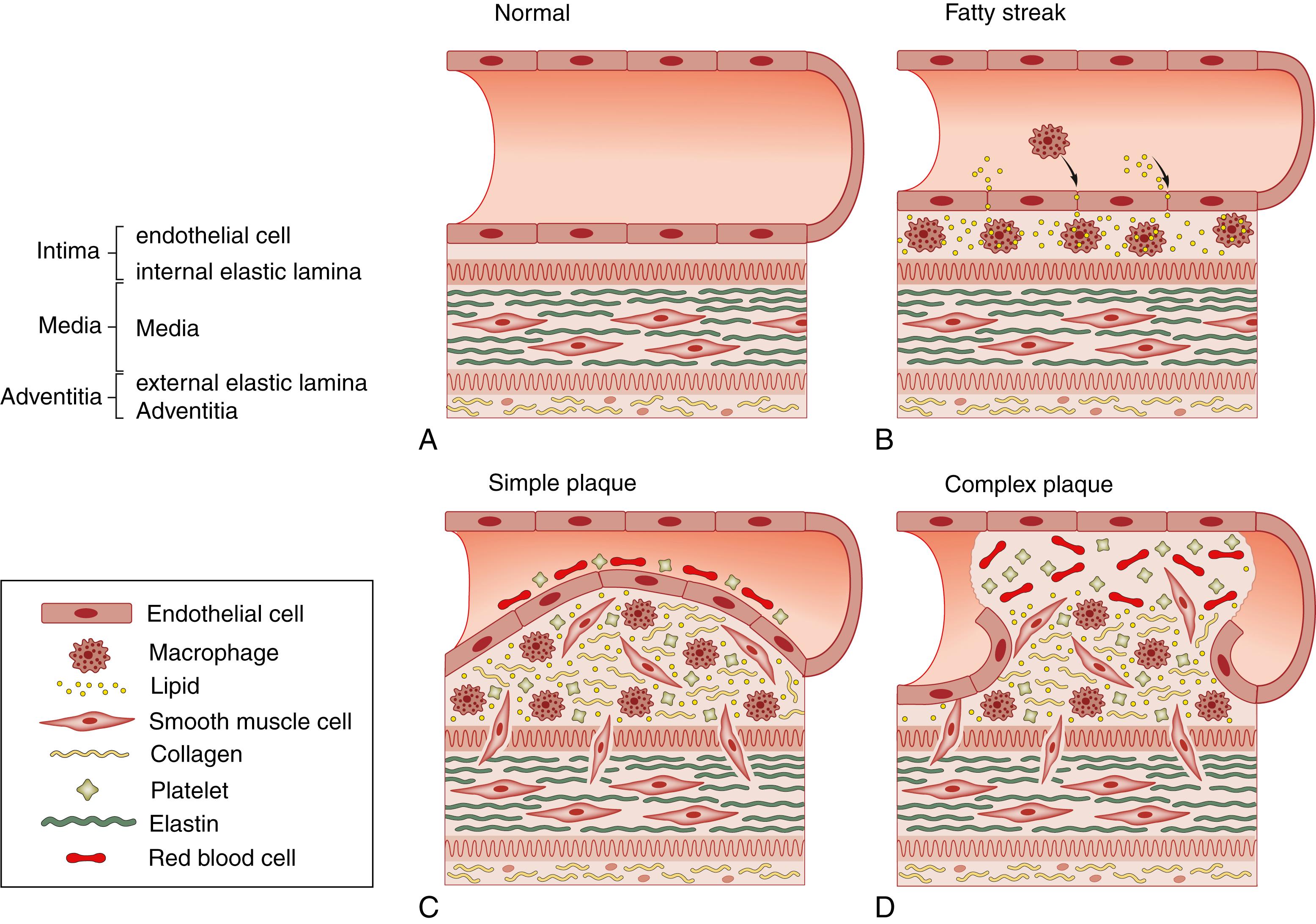
The main risk factor for the development of atherosclerosis is smoking. Hypercholesterolaemia and hypertriglyceridaemia are also important risk factors. Arterial disease is more common in patients with diabetes, who have disordered glucose and lipid metabolism.
Atheroma often appears first where blood flow exerts high levels of shear stress on the arterial wall, for example, at vessel bifurcations. Hypertension, which increases this stress, is an important predisposing factor for arterial disease.
Injury increases the permeability of the endothelium to lipids and inflammatory cells, which become deposited in the subendothelial layer. At this point, atheroma forms a discoloured but flat yellow patch (fatty streak).
Leucocytes adhere to the overlying damaged endothelium, migrate into the subendothelial space, digest lipid to become ‘foam’ cells and liberate free radicals and proteases that destroy the arterial wall. They also liberate cytokines, which attract further leucocytes and smooth muscle cells from the media. The overlying endothelium becomes increasingly ‘sticky’, leading to platelet deposition and thrombosis.
Smooth muscle cells migrate from the media into the subendothelial space and begin to proliferate. They take on the properties of fibroblasts and lay down collagen. At this stage, the atheroma is raised and encroaches upon the lumen of the artery.
At this point, the plaque comprises a thin ‘cap’ of endothelium stretched over a mass of lipid and inflammatory and smooth muscle cells. Intraplaque haemorrhage from immature new blood vessels that infiltrate the lesion (angiogenesis) weakens the plaque. Further chemical and/or physical injury can lead to rupture and the exposure of highly thrombotic plaque contents to the flowing blood. This results in acute thrombotic occlusion of the vessel and/or distal embolisation. It is this sudden decompensation that leads to the most serious and dramatic clinical presentations of arterial disease. Rupture can also occur in a plaque that has hitherto been completely asymptomatic.
The clinical manifestations of arterial disease depend on the following:
The anatomical site of the disease
Whether the artery is an end-artery or well collateralised
The speed with which the disease has developed
Whether the underlying process is primarily haemodynamic, thrombotic, atheroembolic or thromboembolic or attributable to aneurysmal dilatation or dissection
The presence of other comorbidities and the general condition of the patient.
The patient’s symptoms and signs will depend on the territory supplied by the affected artery:
Coronary arteries: angina, myocardial infarction (MI)
Cerebral circulation: stroke, transient ischaemic attack (TIA), amaurosis fugax, vertebrobasilar insufficiency (VBI)
Renal arteries: hypertension, renal failure
Mesenteric arteries: mesenteric angina, acute intestinal ischaemia
Limbs: intermittent claudication (IC), chronic limb threatening ischaemia (CLTI), acute limb ischaemia
The clinical picture also depends on whether the affected artery is an end artery-the only supply to the distal tissues (e.g., coronary artery and the myocardium) or is part of a collateral network one of several arteries supplying the area (e.g., internal carotid artery and the brain). This may vary between patients; for example, in a patient with a complete circle of Willis, occlusion of one internal carotid artery may be asymptomatic, whereas with an incomplete circle, occlusion is more likely to cause a stroke.
Chronic atheroma develops slowly over months or years; with time, through a process of neovascularisation and angiogenesis, a collateral supply to the distal tissues will usually develop, such that when the main artery finally occludes, there may be minimal change in the patient’s clinical condition. The most common example is where the profunda (deep) femoral artery (PFA) collateralises around a diseased superficial femoral artery (SFA) in patients with IC (see following discussion). By contrast, the sudden occlusion of a previously normal artery is likely to cause severe distal ischaemia (because there has been no time for collateral vessels to develop).
The mechanism of injury has a major influence on the clinical presentation, prognosis and treatment of arterial disease ( Fig. 22.2 ).
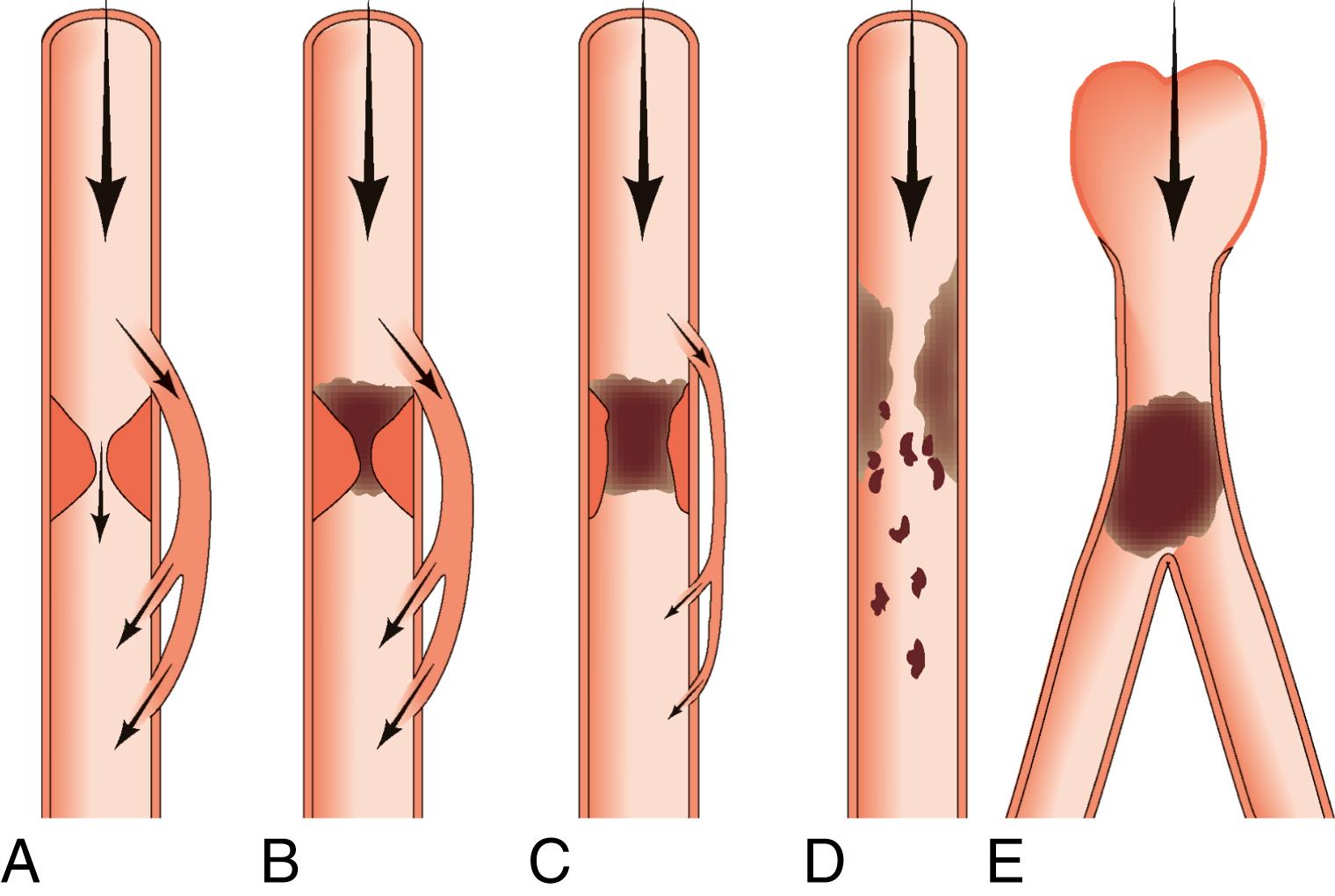
An atheromatous plaque must reduce the cross-sectional area of an artery by about 70% to cause an appreciable drop in flow at rest, a so-called ‘critical stenosis’. However, on exertion—for example, walking—a much lesser stenosis may become flow limiting. The reason for this is that the pressure drop across a stenosis is proportional to the square of the velocity of the blood entering that stenosis; on exercise, blood velocity increases markedly. The clinical consequence of this is that the lesion only becomes symptomatic on exertion. This type of mechanism tends to have a relatively benign course; IC as a result of SFA stenosis is a common example.
By the time a ‘critical’ stenosis occludes, the collateral supply may be so well developed that the event is clinically silent. However, if a plaque that has been causing little or no haemodynamic impairment suddenly ruptures, then acute thrombosis of the vessel can have severe consequences. Such an event can cause MI (coronary arteries) or stroke (internal carotid artery) in a previously asymptomatic patient.
The effect that embolising plaque contents (predominantly cholesterol) or adherent thrombi (predominantly platelets) have upon the distal circulation depends on the factors outlined previously, in addition to the embolic load. Perhaps the best-known example is atheroembolism from an internal carotid artery plaque, which can cause small, discrete and temporary areas of cerebral and retinal ischaemia that manifest clinically as TIA and amaurosis fugax. If the embolic load is high, however, these emboli may cause irreversible occlusion of major distal vessels, leading to stroke and retinal infarction (monocular blindness).
The most common source of thromboembolism in high-economic countries is from the left atrial appendage in association with atrial fibrillation (AF). Historically, and in low- and middle-economic countries, valvular heart disease, usually from rheumatic heart disease, was the predominant source of cardiac thromboemboli. The clinical consequences are usually dramatic because the thrombus load is often large and tends to suddenly and completely occlude a large or medium-sized vessel that has previously been healthy and around which there is therefore no collateral supply. This is an important cause of stroke and acute limb ischaemia.
The lower-limb arterial tree comprises the aortoiliac segment above the inguinal ligament, the femoropopliteal segment and the infrapopliteal segment ( Fig. 22.3 ).
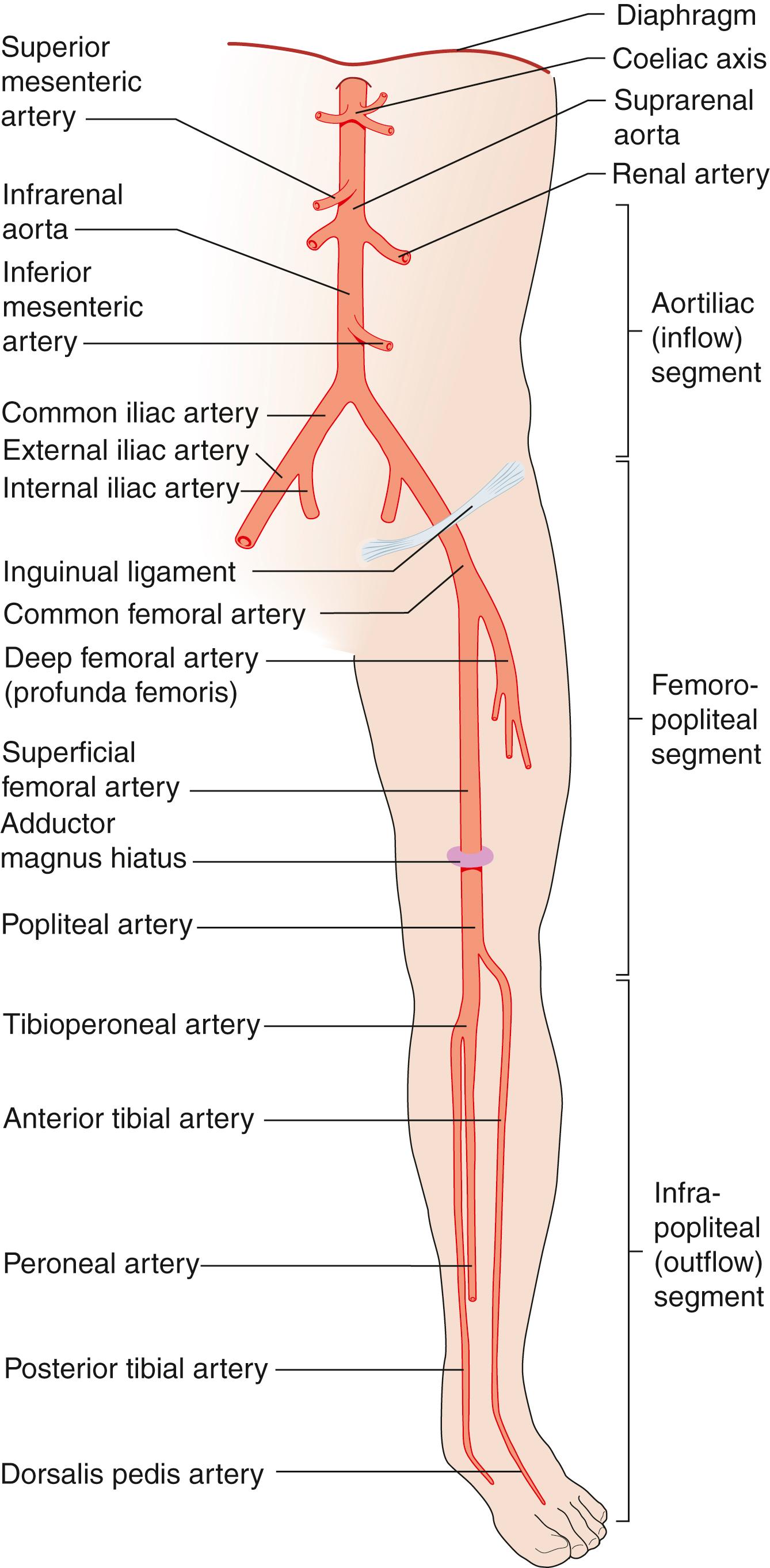
Chronic lower-limb ischaemia presents as two distinct clinical entities, IC and CLTI, which have different epidemiologies, natural histories, treatments and prognoses (see following discussion).
On examination, the chronically ischaemic limb is usually characterised by the following:
Skin that is thin and dry
Pallor, particularly on elevation. Upon dependency, the foot becomes bright red; this is known as dependent rubor or ‘sunset foot’ and is a result of reactive hyperaemia—the microcirculation of a severely, chronically ischaemic limb is vasodilated to maximise extraction of oxygenated blood (Buerger’s test).
Superficial veins that fill sluggishly in the horizontal position and empty upon minimal elevation (venous guttering)
Nails that are brittle and crumbly
Muscle wasting
Reduced temperature
Pulses that are weak or absent and sometimes associated with thrills on palpation and bruits on auscultation
All patients admitted to hospital must have their pulse status recorded. In IC and CLI, the popliteal and pedal pulses are usually absent. If there is aortoiliac disease, then one or both femoral pulses may be weak or absent. The presence of a thrill and/or bruit denotes turbulent flow. However, in the presence of effective collateralisation, especially in younger patients, pulses may sometimes be present at rest despite significant proximal arterial disease.
The ratio between the ankle and brachial blood pressures is a simple method of diagnosing peripheral arterial disease. An ankle-to-brachial pressure index (ABPI) of <0.9 is 90% sensitive and 95% specific for diagnosing lower-limb arterial disease. The latter is recorded in the normal way, the former using an ankle cuff and a handheld Doppler device ( Fig. 22.4 ).
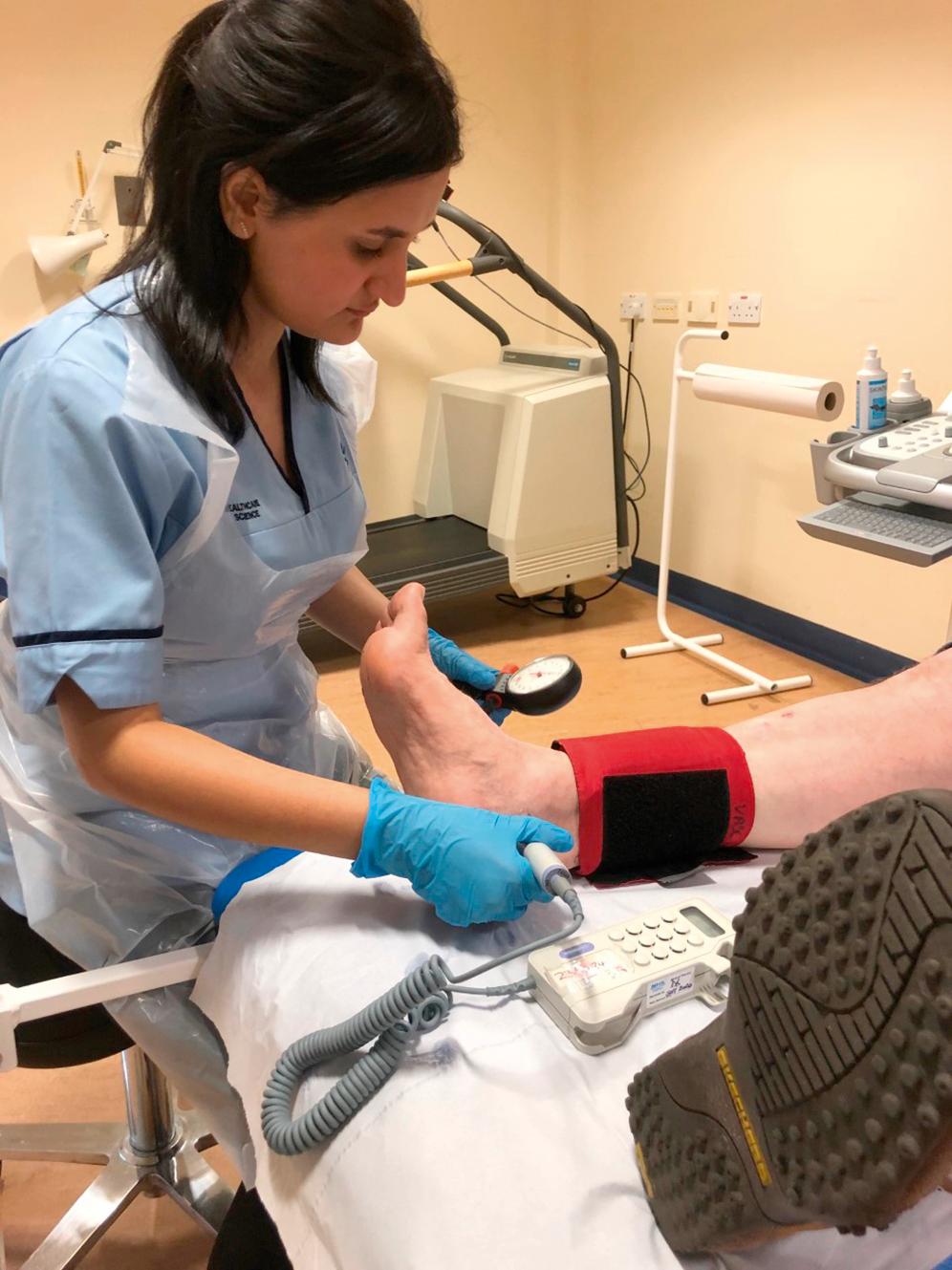
IC is the most common manifestation of peripheral arterial disease, affecting up to 1 in 20 people over 60 years of age.
Limb loss is uncommon (1–3% over 5 years), but myocardial infarction and stroke are 3 times more common than in a nonclaudicant population (up to 5–10% per year).
The mainstays of treatment are risk-factor modification (most importantly, complete and permanent smoking cessation), statin and antiplatelet (aspirin, clopidogrel) therapy and (supervised) exercise. This so-called best medical therapy (BMT) leads to a clinically significant improvement in walking distance in the majority of patients; more importantly, it improves health-related quality of life and increases longevity.
Normally, patients should not be considered for surgical or endovascular intervention until they have been compliant with BMT for at least 6 months; intervention in the face of continued smoking is very unlikely to produce meaningful or durable benefit and is cost-ineffective.
Intervention includes angioplasty, stenting and bypass surgery. Long-term results are generally much better in the larger-sized vessels of the aorto-iliac segment than below the inguinal ligament.
Because lower-limb arterial disease most frequently affects the SFA ( Fig. 22.5 ), IC is usually characterised by pain on walking in the muscles of one or both calves. If the iliac arteries are affected, then that pain may also be felt in the thigh and even the buttock (internal iliac disease). The pain comes on after a reasonably constant ‘claudication distance’ and usually subsides rapidly and completely on cessation of walking. Resumption of walking causes the pain to return. These and other features distinguish it from neurogenic and venous claudication ( Table 22.1 ).

| Arterial | Neurogenic | Venous | |
|---|---|---|---|
| Pathology | Stenosis or occlusion of major lower-limb arteries | Lumbar nerve roots or cauda equina compression (spinal stenosis) | Obstruction to the venous outflow of the leg as a result of iliofemoral venous occlusion secondary to deep venous thrombosis |
| Site of pain | Muscles: usually the calf but may affect thigh and buttock | Ill-defined; whole leg; shooting in nature; may be associated with tingling and numbness | Whole leg Bursting in nature |
| Laterality | Usually unilateral if femoro-popliteal, bilateral if aortoiliac disease | Often bilateral | Nearly always unilateral |
| Onset | Gradual onset after walking the ‘claudication distance’ | Often immediate upon walking or even on standing up | Gradual onset but may be present from the moment walking commences |
| Relieving features | On cessation of walking, the pain disappears completely in 1–2 minutes | On cessation of walking, the pain may gradually subside over 5–10 minutes The patient often has to sit down or lean against something to obtain relief |
The patient usually needs to elevate the leg to obtain relief |
| Colour | Normal or pale | Normal | Cyanosed Often visible varicose veins and venous skin changes |
| Temperature | Normal or cool | Normal | Normal or increased |
| Swelling | Absent | Absent | Always present |
| Pulses | Reduced or absent | Normal | Present, but may be difficult to feel because of swelling |
| Straight leg raising | Normal | Limited | Normal |
Typically, the SFA first becomes narrowed at the adductor canal ( Fig. 22.6A ). Ankle pulses may be palpable but are diminished, and a bruit may be heard at or below the stenosis. The ABPI is often (near) normal at rest but falls after exercise.
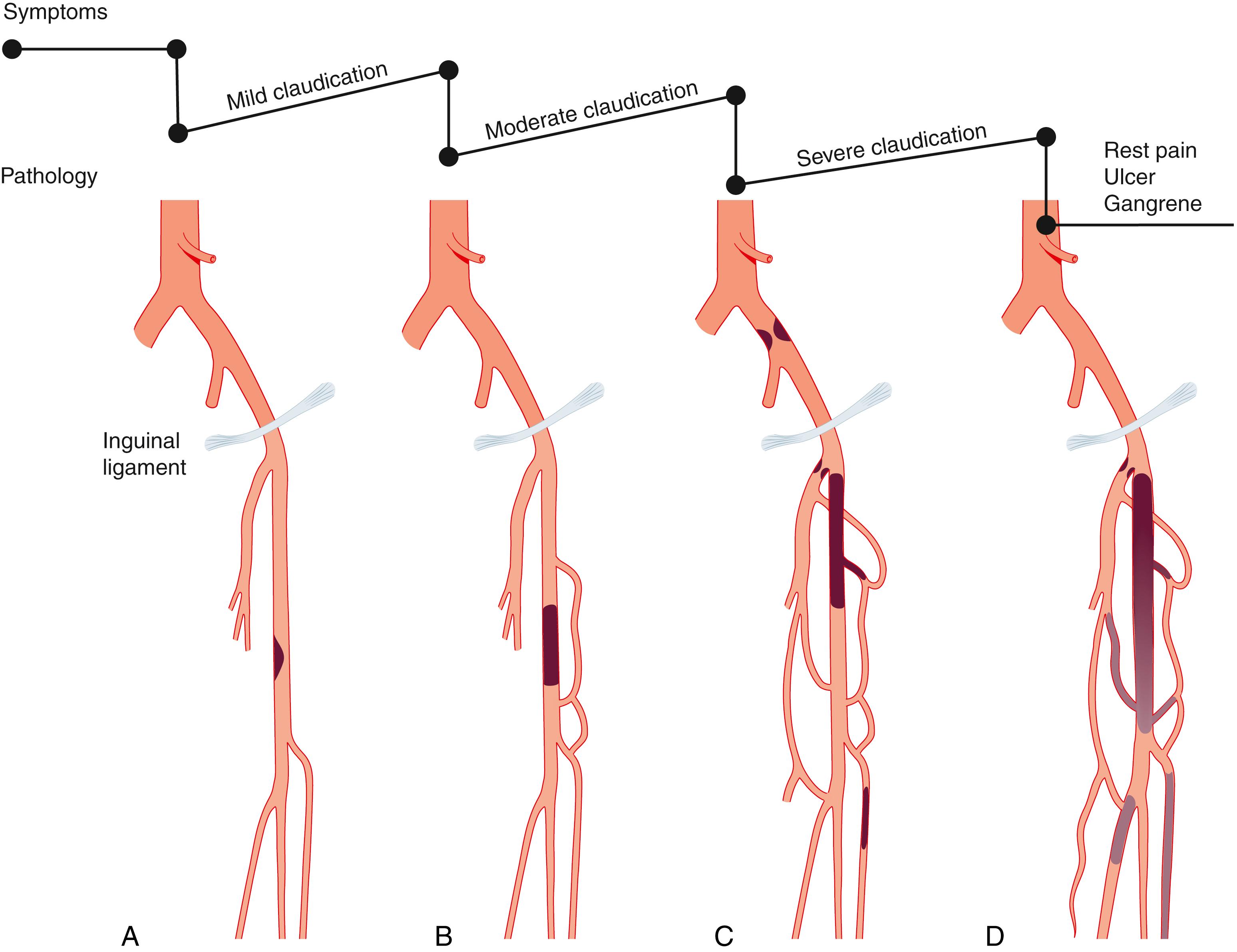
With time, collateral arteries arising from the PFA enlarge and elongate so that they carry a higher proportion of the blood flow to the lower leg. As a result, in the majority of patients, symptoms gradually improve or even disappear. However, very occasionally, the stenosed SFA undergoes an acute thrombotic occlusion (see Fig. 22.6B ). This may lead to a sudden deterioration in walking distance or even an acutely ischaemic limb. Ankle and popliteal pulses will be absent at this stage.
The evolution of the collateral circulation may lead to an improvement in symptoms and walking distance. This phase of moderate claudication can remain stable for several years. However, without BMT (see following discussion) and risk-factor modification, the atherosclerosis will progress to involve other segments, such as the aortoiliac, PFA, and tibial vessels (see Fig. 22.6C ). The IC will progress to become severe, restricting the patient’s ability to walk to less than 100 m; the scope for spontaneous improvement diminishes steadily. As the disease progresses further in site and severity, symptoms may worsen to a point where chronic limb-threatening ischaemia (CLTI) develops as a result of multilevel disease (see Fig. 22.6D ). Such patients will often go on to develop night/rest pain and are at risk of limb loss (see following discussion).
An understanding of this cyclical pattern of exacerbation and resolution in IC is important because spontaneous improvement may mislead the patient into thinking all is well and that there is no longer a need to comply with medical advice (see following discussion)—and in particular, that they can continue to smoke.
IC affects up to 5% of people aged over 60 years. Provided patients comply with BMT, only a small proportion (1–2%) of those affected by IC will deteriorate to a point where amputation and/or revascularisation to prevent amputation is required. However, the annual mortality rate is 5% to 10% per year, which is 2 to 3 times higher than the rate for an age- and sex-matched nonclaudicant population. A diagnosis of claudication is associated with a 5-year risk of death of 25%, similar to a diagnosis of breast cancer or lymphoma. This is because IC is a marker of widespread atherosclerosis, with the attendant risk of cardiovascular events and deaths from MI, stroke and limb loss. The emphasis is therefore on the prolongation of life; in most patients, measures to reduce cardiovascular events will also improve the functional performance of the patient.
Whereas IC is usually a result of single-level disease, CLTI (sometimes also termed critical limb ischaemia (CLI) or severe limb ischaemia (SLI) ) is caused by multiple lesions affecting different arterial segments down the leg (see Fig. 22.6D ). These patients have a syndrome of peripheral arterial disease in combination with rest pain, gangrene, or lower limb ulceration for > 2 weeks’ duration; their ankle blood pressure is often 50 to 70 mm Hg or less. Without revascularisation, such patients will often lose a limb, and sometimes their lives, in a matter of months. Twenty-five percent of people with CLTI will die, and 25% will lose a leg within 1 year.
Ischaemic ‘night pain’ typically develops in the forefoot a few hours after going to bed. The pain results from the accumulation of anaerobic metabolites (acidosis) as a result of inadequate delivery of oxygenated blood to the distal foot. Hypoperfusion develops from the loss of the beneficial effects of gravity and from normal circadian physiology that causes cardiac output to fall at night. The pain is extreme and wakes the patient from sleep. At first the pain may be relieved by dangling the leg out of bed to restore the advantage of gravity, but as the disease progresses, the patient has to get up and walk about to gain relief. Patients typically resort to sleeping seated in a chair. This causes dependent oedema and increases interstitial tissue pressure, further reducing arterial perfusion. The patient is then in a vicious cycle of increasing pain and sleep loss. At this point, even a minor injury to the foot will fail to heal, and the entry of bacteria leads to infection and an increase in the metabolic demands of the foot. The result is the rapid formation of ulcers, gangrene and, without treatment, limb loss and death.
Approximately 40% of patients with CTLI have diabetes, and such patients pose a number of unique problems for vascular specialists:
Arteries are often calcified, leading to vessel incompressibility, which results in spuriously high ankle pressures and inaccurate ABPI measurements and also impairs imaging with duplex ultrasound or computed tomography (CT) angiogram.
Calcified vessels make surgery and angioplasty technically difficult.
Impaired immune responses to foot infections
Severe multisystem arterial disease (coronary, cerebral and peripheral), which increases the risks of intervention
In the lower limbs, diabetic vascular disease has a predilection for the infrapopliteal vessels. Although vessels in the foot may be spared, the technical challenge of performing a satisfactory bypass or angioplasty to these small-calibre vessels is considerable.
Altered foot biomechanics and frequent coexisting neuropathy may lead to altered distribution of forces through the foot, resulting in ulceration in its own right (see following discussion).
The term diabetic foot refers to the combination of ischaemia, neuropathy, biomechanical change and immunocompromise that renders the feet of diabetic patients vulnerable to ulceration, sepsis and gangrene. Diabetic neuropathy affects motor, sensory and autonomic nerves.
Sensory neuropathy renders the patient incapable of feeling pain. Minor trauma—for example, from a stone in the shoe—remains unnoticed. Even severe ischaemia and/or tissue loss that would prompt a patient with intact sensation to seek urgent medical advice may be completely painless in individuals with diabetes. For this reason, patients with diabetes often present late, with extensive destruction of the foot. Sensory neuropathy also affects proprioception such that, when walking, pressure is applied at unusual sites. This leads to ulcer formation and even joint disruption (Charcot’s joint).
The normal structure and function of the foot depend not only on ligaments but also on the long and short flexors and extensors of the calf and foot. The former is affected more than the latter by motor neuropathy, leading to weakness and atrophy. The result is that the long extensors of the toes are unopposed, and the toes become increasingly dorsiflexed. This exposes the metatarsal heads to abnormal pressure, and they are a frequent site of callus formation and ulceration ( Fig. 22.7 )
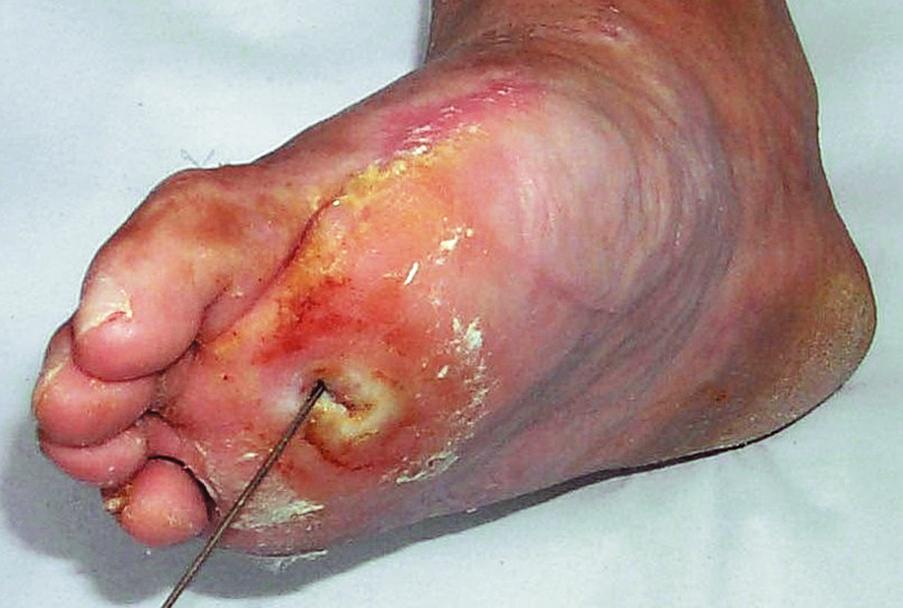
Autonomic neuropathy leads to a dry foot deficient in the sweat that normally lubricates the skin and contains antibacterial properties. The result is scaling and fissuring of the skin and the creation of a portal of entry for bacteria. Abnormal blood flow in the bones of the ankle and foot resulting from a loss of autonomic control may also contribute to osteopenia and bony collapse (Charcot’s foot).
If the blood supply to the foot is adequate, dead tissue can be excised in the expectation that healing will occur, provided infection is controlled and the foot is protected from pressure (so-called off-loading ). If there is ischaemia as well, the priority is to revascularise the foot, if possible. Sadly, many patients with diabetes present late, with extensive tissue loss and ‘unreconstructable’ disease, which accounts for the very high amputation rate.
All patients with atherosclerotic vascular disease should be strongly urged to comply with BMT, which comprises the following:
Immediate, absolute and permanent cessation from smoking. This is by far the most important intervention and prognostic factor. In the face of continued smoking, other treatments are rendered largely ineffective, and disease progression, limb loss and death (usually from cardiovascular causes) within a few years are the likely outcome.
Control of hypertension according to current guidelines (e.g., see the National Institute for Health and Care Excellence (NICE) guideline at https://www.nice.org.uk/guidance/ng136 ).
Control of hypercholesterolaemia according to current guidelines (e.g., see the NICE guideline at https://www.nice.org.uk/guidance/cg181 ).
All vascular patients should be prescribed lipid-lowering drugs, usually a statin. Ideally, their baseline total cholesterol will be reduced by a third (ideally to below 4 mmol/L). Statins also stabilise atheromatous plaques and may prevent the development and progression of aneurysmal disease through as-yet incompletely understood antiinflammatory mechanisms.
Prescription of an antiplatelet agent (for guidance, see the NICE Clinical Knowledge Summary at https://cks.nice.org.uk/antiplatelet-treatment ). This is either aspirin (75 mg daily) or clopidogrel (75 mg daily); the latter is a more effective. Anticoagulation with warfarin or direct-acting oral anticoagulants should normally be reserved for patients with AF or ischaemic heart disease.
Regular exercise. It is widely accepted that supervised exercise in a healthcare environment is more effective than (unsupervised) simple advice to exercise.
Control of obesity. This will help bring down blood pressure, cholesterol and the ‘strain’ of walking; diabetes will also be easier to control. Surgical and endovascular intervention are much more difficult and morbid in obese patients.
The identification and active treatment of patients with diabetes. This includes foot care (for further information, see the guidelines of the International Working Group on the Diabetic Foot at https://iwgdfguidelines.org ).
Compliance with BMT not only increases walking distance but also affords very significant protection against cardiovascular events and improves quality of life and life expectancy. Unfortunately, many patients fail to comply and, in particular, continue to smoke. Endovascular or open surgery for IC should not normally be considered until the patient is fully compliant with BMT and that therapy has been given an adequate chance to effect symptomatic improvement. Intervention in the face of continued smoking is usually clinically and cost-ineffective and represents a poor use of healthcare resources. Revascularisation is in addition to, not instead of, BMT, a point that often has to be emphasised to patients anxious to return to their previous lifestyle-related risk factors.
By the time a patient develops CLTI, it is often the case that, without surgical or endovascular revascularisation, the limb will be lost. However, this does not in any way detract from the value of instituting BMT in such patients. On occasion, BMT may improve the condition of the leg such that intervention is not required or a lesser procedure becomes an option. In those undergoing intervention, BMT undoubtedly reduces the overall risks and increases procedural success.
Balloon angioplasty (BAP), with or without stenting, can be used in the iliac, femoral, popliteal and crural arteries and is usually performed under local anaesthesia ( Fig. 22.8 ). An endovascular wire is used to navigate across a stenosis or burrow through an occluded artery. A balloon catheter is introduced over the wire, and the balloon is inflated. This enlarges the lumen by disrupting the atheromatous plaque. In occlusions and complex disease, metal stents may be deployed across the lesion to improve patency and reduce emboli from the fractured plaque. Sometimes these balloons and stents are coated with antiproliferative drugs (so-called drug-eluting balloons and stents ) that can reduce the inflammatory arterial scarring
‘For patients who survived for at least 2 years after randomization, a BSX-first revascularization strategy was associated with a significant increase in subsequent overall survival and a trend towards better amputation free survival. BAP was associated with a significantly higher early failure rate than BSX. Many BAP patients ultimately required surgery. BSX outcomes after failed BAP are significantly worse than for BSX performed as a first revascularization attempt. BSX with vein offers the best long-term outcome but BAP appears superior to prosthetic BSX.’
(neo-intimal hyperplasia) that follows any intervention and can lead to restenosis and reocclusion. The success and durability of endovascular intervention diminish with distal progression down the arterial tree. Endoluminal repair of the aortoiliac segment has become the treatment of choice in most vascular units because of its high patency rates and low morbidity compared with open surgery. Infrainguinal BAP and, less commonly, stenting are also widely used in the management of IC and CLTI. The evidence base for infrapopliteal BAP is less well developed.
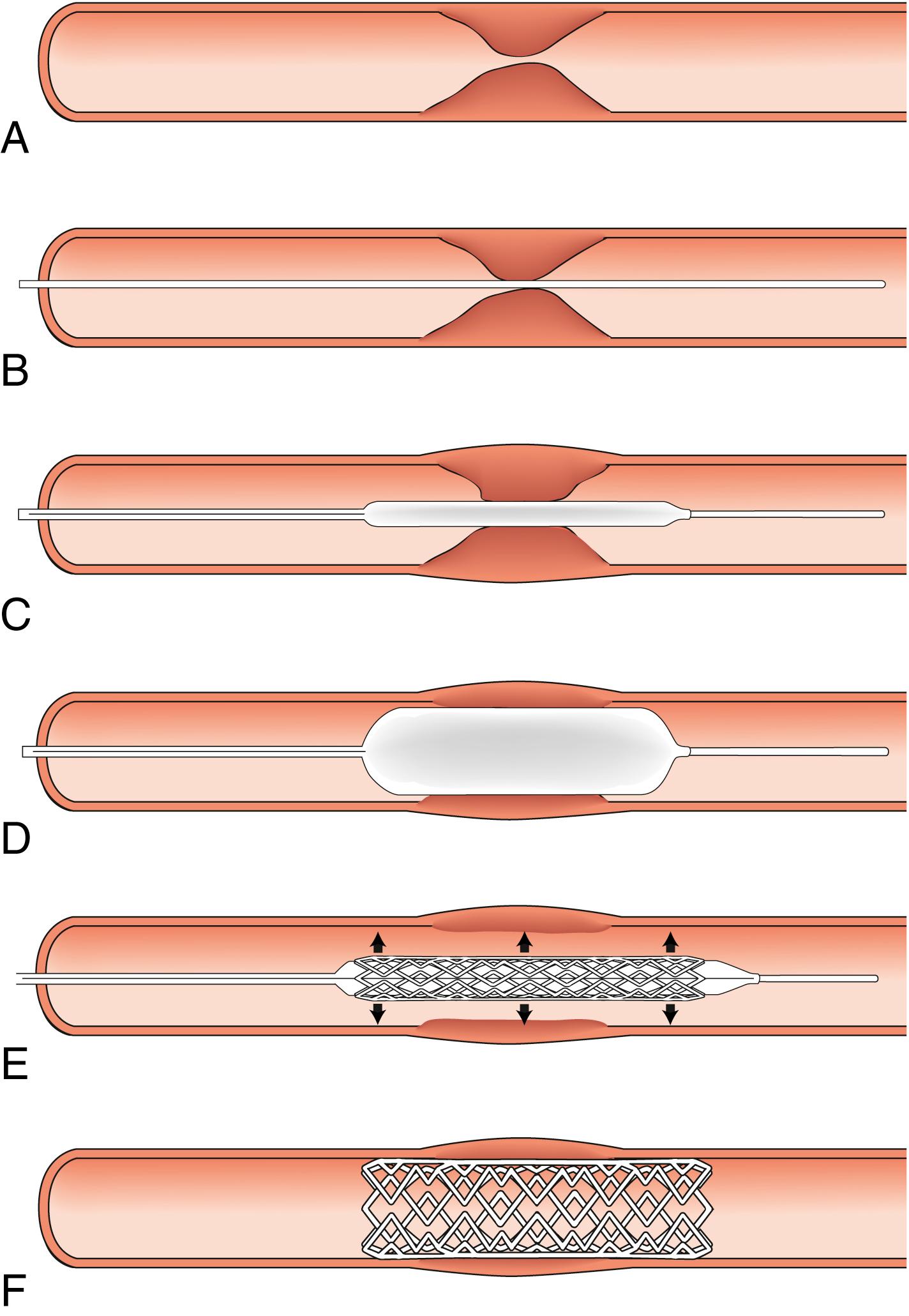
Endoluminal treatment (BAP, stent) should be used selectively in patients with IC because it is associated with a 1% to 2% morbidity rate and rarely mortality. There is some evidence that patients who have intervention for claudication have poorer long-term outcomes than those who are managed with BMT and exercise. There is controversy with regard to its role in the femoropopliteal and infrapopliteal segments because of a perceived lack of durability of benefit as a result of restenosis. By contrast, most vascular specialists believe that endoluminal therapy should be considered in patients with IC resulting from aortoiliac disease (absent or reduced femoral pulses) because patients
tend to be younger, so that their symptoms have a greater impact on their quality of life and livelihood;
often have short-segment disease that is amenable to BAP, with or without a stent;
often have (relatively) normal infrainguinal arteries, so that restoring flow in the aortoiliac segment effects a dramatic improvement in the perfusion to their legs;
tend to be more symptomatic, with shorter walking distances and bilateral symptoms; and
the long-term patency of BAP and stenting is optimal in high-flow, large-calibre vessels, leading to a durable clinical benefit in many patients.
A UK randomised controlled trial comparing BAP and bypass surgery (BSX) ( http://basiltrial.com ) showed that although BAP is safer and less expensive than BSX in the short term (12–18 months), BSX (with vein) offers a more durable and complete revascularisation in the longer term (3–5 years; EBM 22.1 ). At the present time, patients with CLTI expected to only live 1 to 2 years and who do not have a suitable vein for the construction of a bypass are probably best treated by BAP where technically possible; all other patients with CLTI are probably best served by BSX. The role for endovascular therapy may increase in the future as technology improves.
Many surgeons are reluctant to perform infrainguinal bypass surgery for IC because of the following:
The risk of limb loss is very low with BMT.
Those patients who fail to comply with BMT (fail to stop smoking) are those most likely to press for surgery because of ongoing symptoms. However, they are also those at greatest operative risk and those least likely to gain durable benefit from their bypass.
Surgery is associated with a significant risk of mortality and major morbidity, with the size of that risk depending on the procedure and the patient but probably approaching 3% to 5% for infrainguinal bypass and 5% to 10% for aorto-bifemoral bypass.
Because most patients have bilateral disease, even if they have unilateral symptoms, successful infrainguinal surgery on one side often reveals limiting IC symptoms on the other, requiring a second operation (the same for endoluminal treatment).
Grafts have a finite patency, especially in those who fail to comply with BMT and, in particular, continue to smoke (the same for endoluminal treatment).
As soon as a bypass graft is inserted, collaterals circumventing the original lesion shrink down. For this reason, when the graft occludes, usually suddenly, the patient is normally returned to a worse situation than before the operation. A patient who was previously a claudicant may now have acute limb-threatening ischaemia, which then forces the surgeon or radiologist to reintervene. Secondary interventions are technically more difficult and are associated with higher risk and a lower patency rate.
As with BAP and stenting, the balance of risks and benefits for open surgery is different in patients with aorto-iliac disease. Although the risk of surgery is higher, the long-term patency rates of such grafts are excellent, and one operation deals with both legs. Whatever the treatment being considered, patients must be made fully aware of the risks and benefits to enable fully informed shared decision making. These discussions must always be accurately recorded in the clinical records; it is good practice to send copies of this to the patient and the primary care doctor.
Endarterectomy involves the direct removal of atherosclerotic plaque and thrombus, and in modern vascular practice, it is largely reserved for carotid and femoral bifurcations ( Fig. 22.9 ).
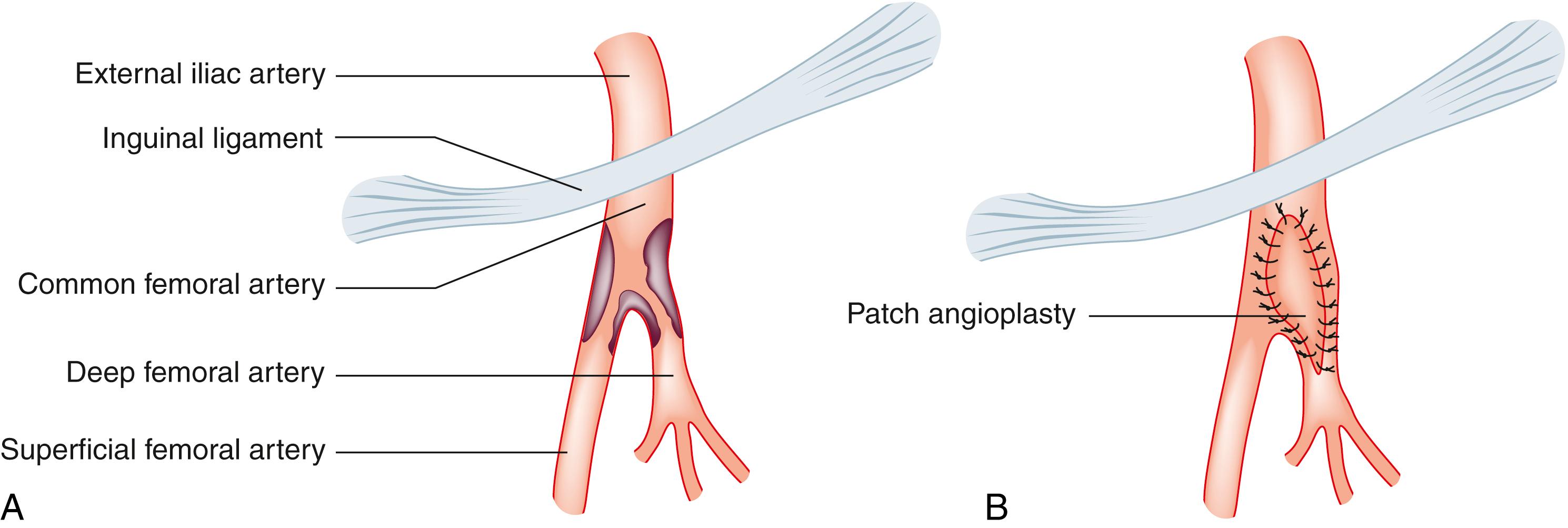
For a surgical bypass operation ( Fig. 22.10 ) to be successful in the long term, three conditions must be fulfilled:
There must be widely open high-flow arteries to act as a source for the graft (inflow).
There must be a suitable conduit to carry blood.
There must be widely open arteries for blood to travel into when it leaves the graft (outflow or runoff).
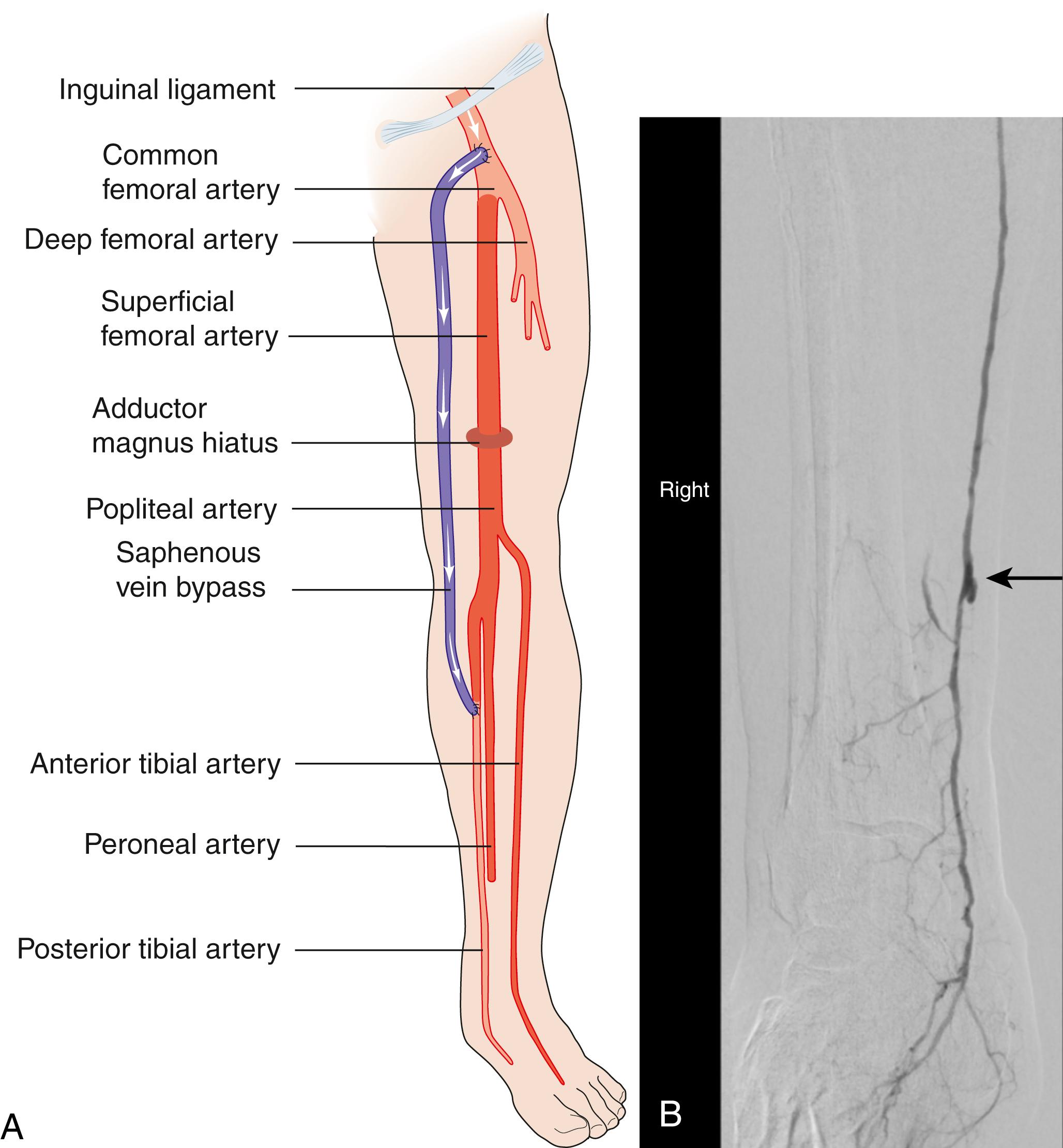
Two main types of conduits are available:
Autogenous material, most commonly the ipsilateral great saphenous vein (GSV).
Prosthetic material, most commonly expanded polytetrafluoroethylene (ePTFE) or Dacron.
The main advantage of vein is that it is lined by endothelium that is actively antithrombotic and profibrinolytic and therefore much less liable to induce coagulation than even the most inert of human-made materials. This translates into much better long-term graft patency. Vein is also much more resistant to infection (see following discussion) and less expensive. It is generally agreed that wherever possible, vein from the leg or arm should be used for infrainguinal reconstruction.
In most bypass operations, the new conduit more or less follows the course of the original artery—a so-called anatomic bypass ( Fig. 22.11 ). Where this is not possible and/or desirable, a so-called extraanatomic bypass can be inserted ( Fig. 22.12 ).
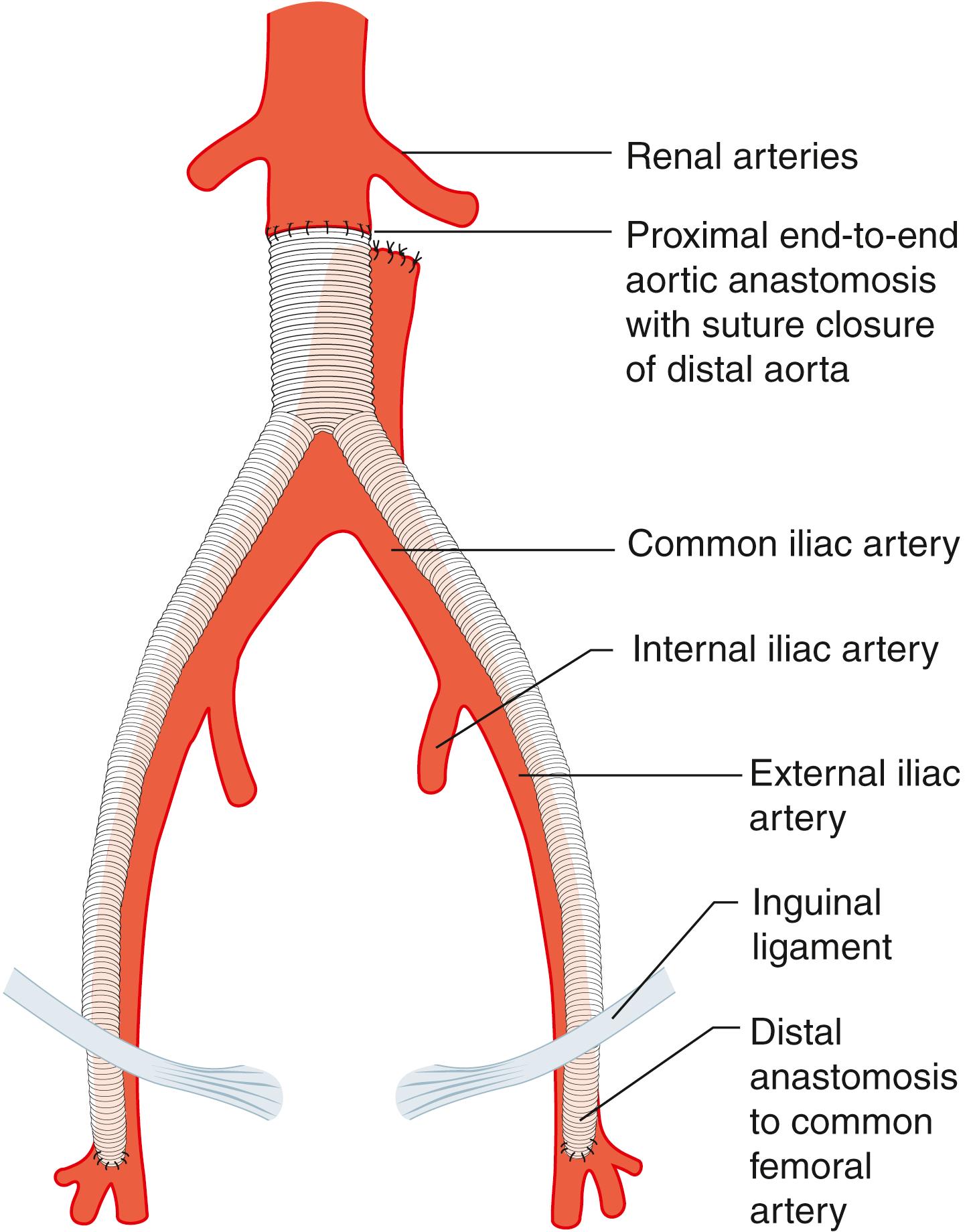
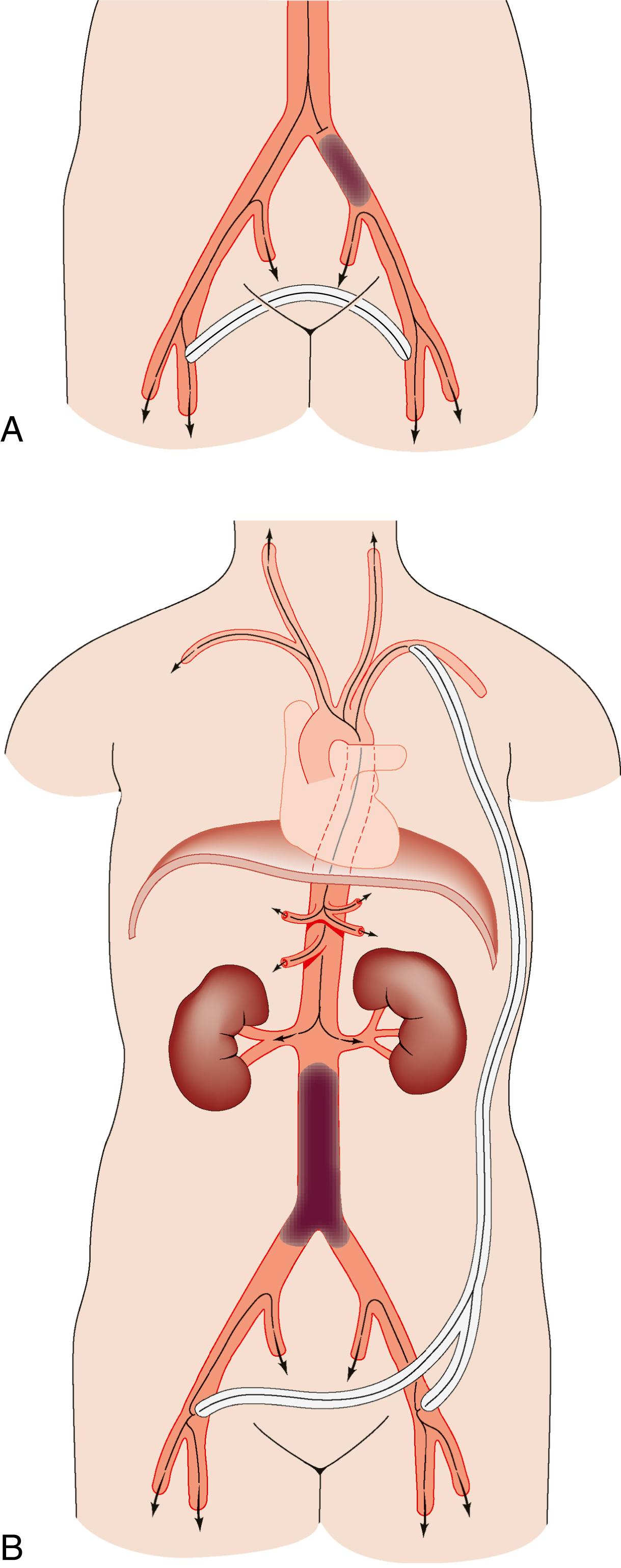
For example, if only one iliac artery is blocked and the patient is unfit for abdominal surgery and unsuitable for endoluminal treatment, a femorofemoral crossover graft can be performed. If both iliac arteries are occluded, then an axillobifemoral graft can be inserted. In general, these extraanatomic grafts have a poorer long-term patency than anatomic aortoiliac reconstructions. However, they are less invasive surgical procedures and are advantageous in high-risk patients or those who have a limited life expectancy.
The morbidity and mortality associated with vascular surgery are often high because patients are usually elderly and unfit, with widespread vascular disease, and the operations are often lengthy, with attendant blood loss. Most morbidity and mortality result from cardiovascular complications. Meticulous perioperative care is essential for optimal results, and close liaison between the surgeon, the anaesthetist and critical care teams is essential. Longer-term major complications include infection and graft occlusion, for which the outcome is better when identified early.
There is some evidence for regular postoperative ultrasonography of vein grafts, typically at 6 weeks and 6 months. This graft surveillance is designed to pick up technical problems with the graft that are likely to increase the risk of failure. It is better to correct a ‘failing’ graft before it has blocked than to try to salvage one that has already occluded. The benefits of graft surveillance are less apparent for prosthetic grafts.
Infection of prosthetic grafts is a serious and growing problem, largely as a result of the increasing prevalence of antibiotic-resistant organisms, including methicillin-resistant Staphylococcus aureus (MRSA). An infected prosthetic graft must usually be removed to treat sepsis and/or to prevent infection-related disruption of the vascular anastomoses resulting in life-threatening haemorrhage. Graft removal renders the distal limb ischaemic, and where possible, a new graft must be sited through fresh uninfected tissue. This can be extremely challenging and is often impossible. Measures to avoid graft infection include the following:
Using vein wherever possible
Perioperative antibiotic prophylaxis
Meticulous surgical technique to minimise operative time and avoid perioperative haematoma
Strict aseptic technique in the operating theatre and ward
Amputation should only be considered for intractable rest pain or ascending sepsis, where limb salvage is considered by a vascular multidisciplinary team to be inappropriate or impossible. In some cases, patients are admitted profoundly unwell and septic from spreading gangrene, and immediate amputation may be the only means of preserving life.
The level of amputation is determined by local blood supply, the status of the joints, the patient’s general health and the patient’s age. The broad principle is to amputate at the lowest level consistent with healing and preserving function ( Fig. 22.13 ). The more proximal an amputation, the better the arterial perfusion and healing potential. It is useful to conserve the knee joint if at all possible because the energy required to walk on a below-knee prosthesis is much less than that required to walk on an above-knee prosthesis. However, if the patient has another comorbidity or disability that would make walking with a prosthesis impossible, there is no point in attempting to conserve the knee joint at the expense of healing. A common situation is where a patient presents with a fixed flexion contracture of the knee. A below-knee amputation in such a patient is usually ill-advised because the contracture will prevent the patient from ever walking and will also result in the stump wound resting on the bed or chair, leading to poor healing and wound breakdown.
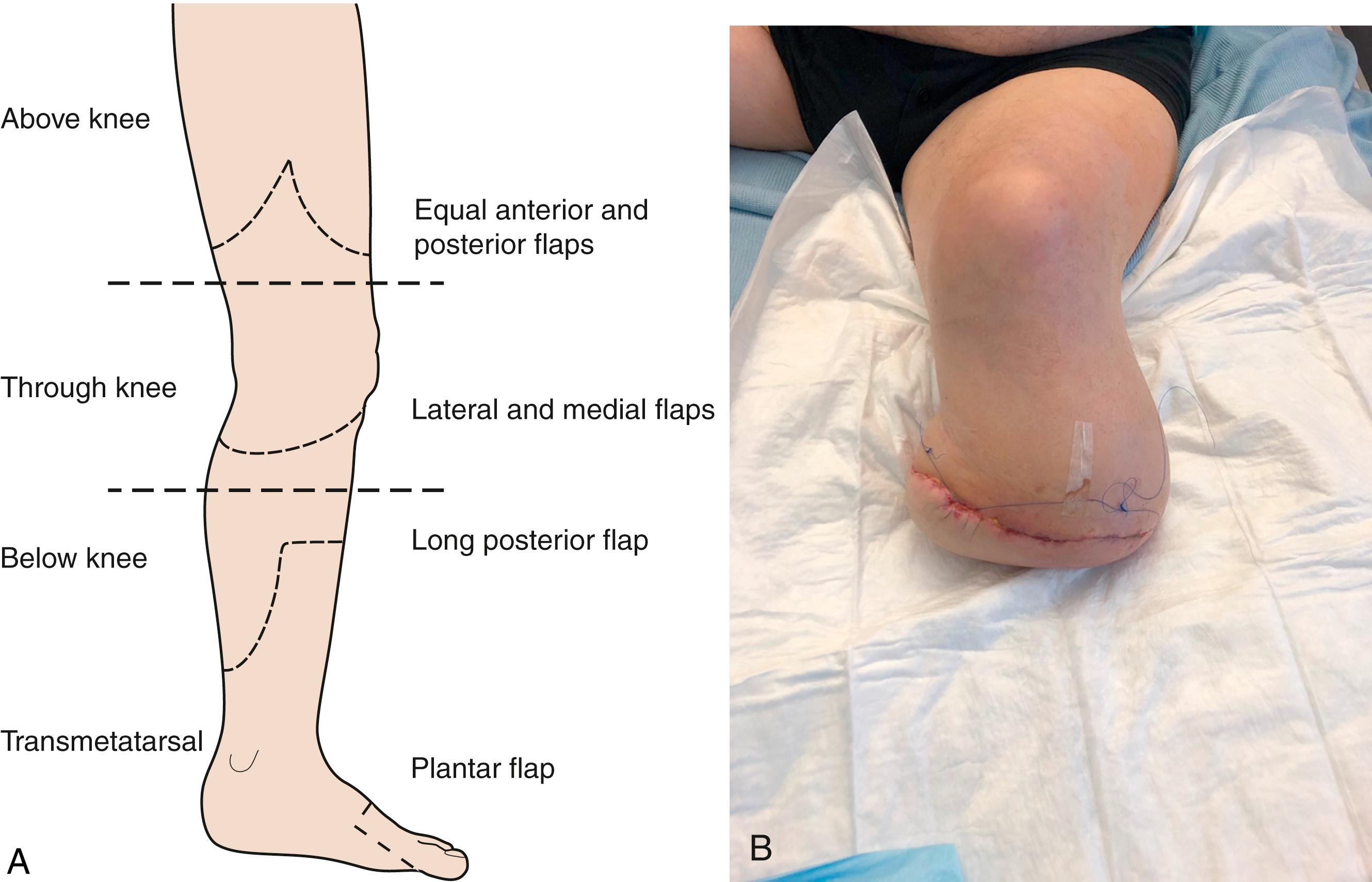
A number of important principles must be observed if primary healing and satisfactory rehabilitation are to be achieved. The in-hospital mortality for major limb amputation approaches 20% and can exceed 30% in the elderly undergoing above-knee amputation. The decision to amputate, the level of amputation and the procedure itself require direct input from an experienced vascular surgeon. In some elderly patients, end-of-life care may be more appropriate than amputation.
The speed of rehabilitation is variable, but typically, at about 1 week the patient should begin to bear weight on the other limb between parallel bars, and at 10 days, the patient should begin to walk with a pneumatic walking aid. If healing is progressing well, a temporary prosthesis can be fitted at about 3 weeks. Final fitting of the artificial limb must await shaping and firming of the stump. Approximately 70% of below-knee amputees and 30% of above-knee amputees eventually walk, although many of these do not persist with their prosthesis. It is important to appreciate that because of the prolonged hospital admission, rehabilitation, home modifications and, in some cases, long-term care, amputation can be a much more expensive option than revascularisation leading to limb salvage.
Phantom limb pain can be a serious problem, especially if pain has not been well controlled before and after the amputation. With appropriate drug therapy, reassurance and time, it usually settles but can take a long time to do so. There is some evidence that if the patient goes to theatre pain-free, the risk of phantom pain can be reduced. For this reason, some surgeons request epidural anaesthesia prior to surgery. Input from a pain specialist can be invaluable.
Occlusive arterial disease is about 10 times more common in the leg than in the arm. This is thought to relate to the evolution of our bipedal gait. Nevertheless, when the arm is affected, treatment can be difficult, and the loss of an arm (especially the dominant one) is even more devastating for the patient than loss of a leg.
The left subclavian artery just proximal to the origin of the vertebral artery is the most common site of disease. This may lead to the following:
Exertional arm pain. This is relatively unusual, even when the subclavian artery is completely occluded, because of collateral supply, mainly from the vertebral artery.
Atheroembolism to the hand. Small emboli lodge in the vessels of the fingers and the hand and lead to symptoms that are often mistaken for Raynaud’s phenomenon, except that in this case the symptoms are unilateral (see following discussion).
Subclavian steal. In this circumstance, when the arm is used, blood is ‘stolen’ from the brain, with retrograde flow via the vertebral artery. This leads to vertebrobasilar ischaemia, characterised by dizziness, cortical blindness and/or collapse when the arm is used ( Fig. 22.14 ).
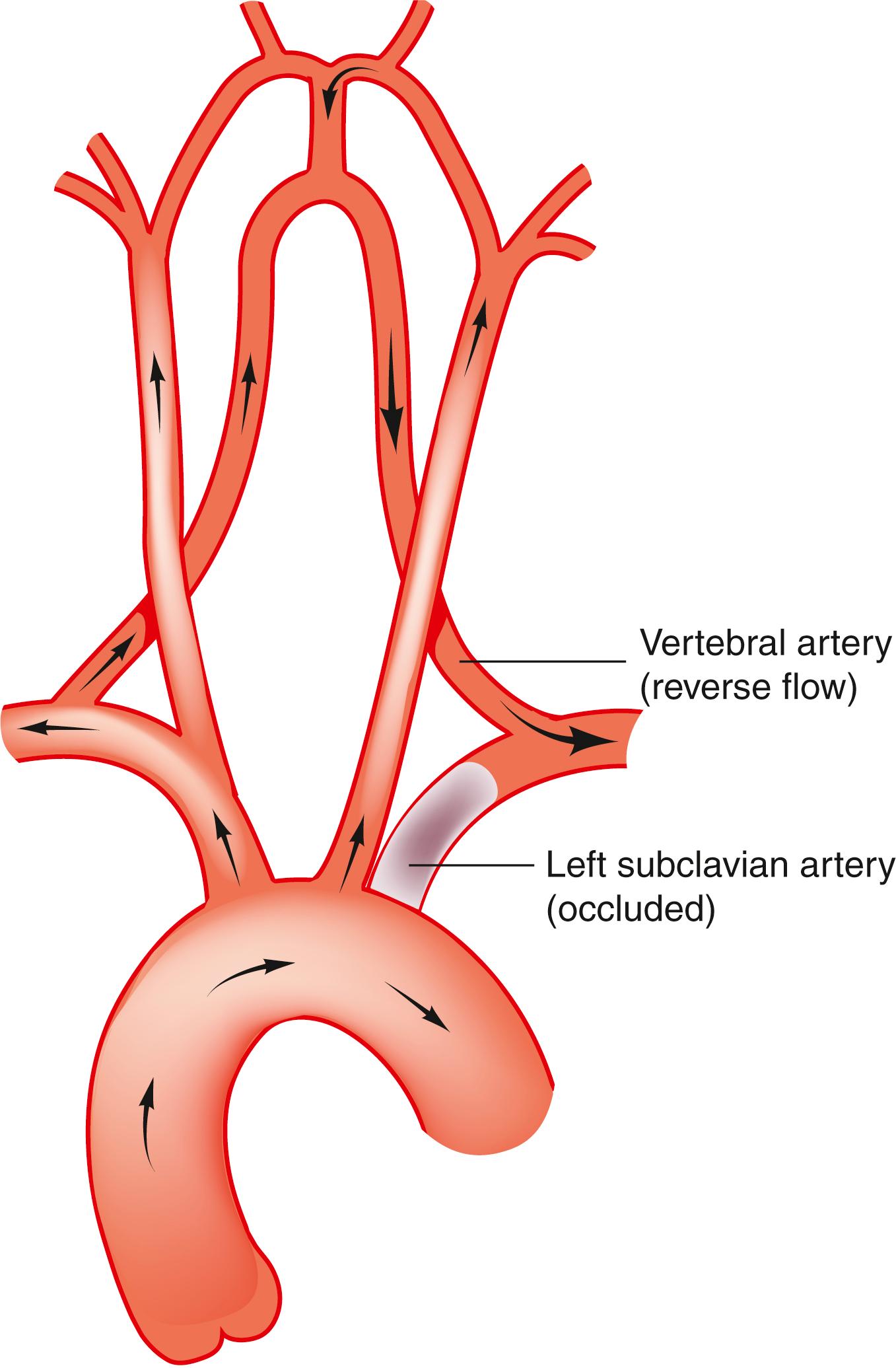
Most subclavian artery disease can be treated by means of BAP and stenting because the results are good and surgical access to the area is difficult. If surgery is required, then the usual operation is carotid–subclavian bypass.
Stroke may be defined as an episode of focal neurologic dysfunction lasting more than 24 hours, of presumed vascular aetiology.
When such symptoms last for less than 24 hours, the episode is described as a TIA .
Amaurosis fugax describes transient, usually incomplete, loss of vision in one eye owing to occlusion of a branch of the retinal artery by cholesterol emboli. The patient typically describes it as a veil or curtain coming down across the eye, which remains for a few minutes and then disappears. Amaurosis fugax never affects both eyes at the same time; it is almost infinitely improbable that emboli would enter both retinal arteries synchronously. Bilateral visual loss is usually a result of occipital ischaemia secondary to VBI (see following discussion). A synchronous amaurosis fugax is, of course, possible in patients with bilateral carotid disease.
In the UK, approximately 80% of strokes are ischaemic, and about 40%% of these are thought to be a result of atheroembolism from the carotid bifurcation. The origin of the internal carotid artery is particularly prone to atherosclerosis. The tighter the degree of stenosis, the more likely it is to cause symptoms. Athero-emboli entering the ophthalmic artery lead to amaurosis fugax or permanent monocular blindness on the same side (ipsilateral). If they enter the middle cerebral artery, they may cause hemiparesis and hemisensory loss on the opposite side (contralateral). If the dominant hemisphere is affected, there may also be dysphasia.
Around 40% of all ischaemic strokes may be caused by atheroembolism from the carotid bifurcation.
Patients with carotid territory minor stroke, TIAs or amaurosis fugax should be assessed by a vascular surgeon with a view to carotid endarterectomy (CEA).
Compared with BMT alone, CEA in addition to BMT significantly reduces the risk of further ipsilateral ischaemic stroke in patients with high-grade symptomatic internal carotid artery stenosis.
For most patients, the benefits of CEA for asymptomatic internal carotid artery stenosis are much more finely balanced with BMT.
Several large trials have shown that with current technology, carotid artery stenting (CAS) can be an effective treatment for carotid stenoses and can be considered as an option in patients at high risk for surgery.
The presence of a ‘carotid’ bruit bears no reliable relationship to the severity of underlying internal carotid artery disease and thus the risk of stroke. Such a bruit may arise from the external carotid artery or be transmitted from the heart. Furthermore, in the presence of a very tight internal carotid artery stenosis, flow may be so slow that no audible turbulence is present. It is important to exclude other causes of cerebral ischaemia and haemorrhage.
Colour flow Doppler ultrasound (duplex) is the initial investigation of choice for imaging the carotid arteries ( Fig. 22.15 ).
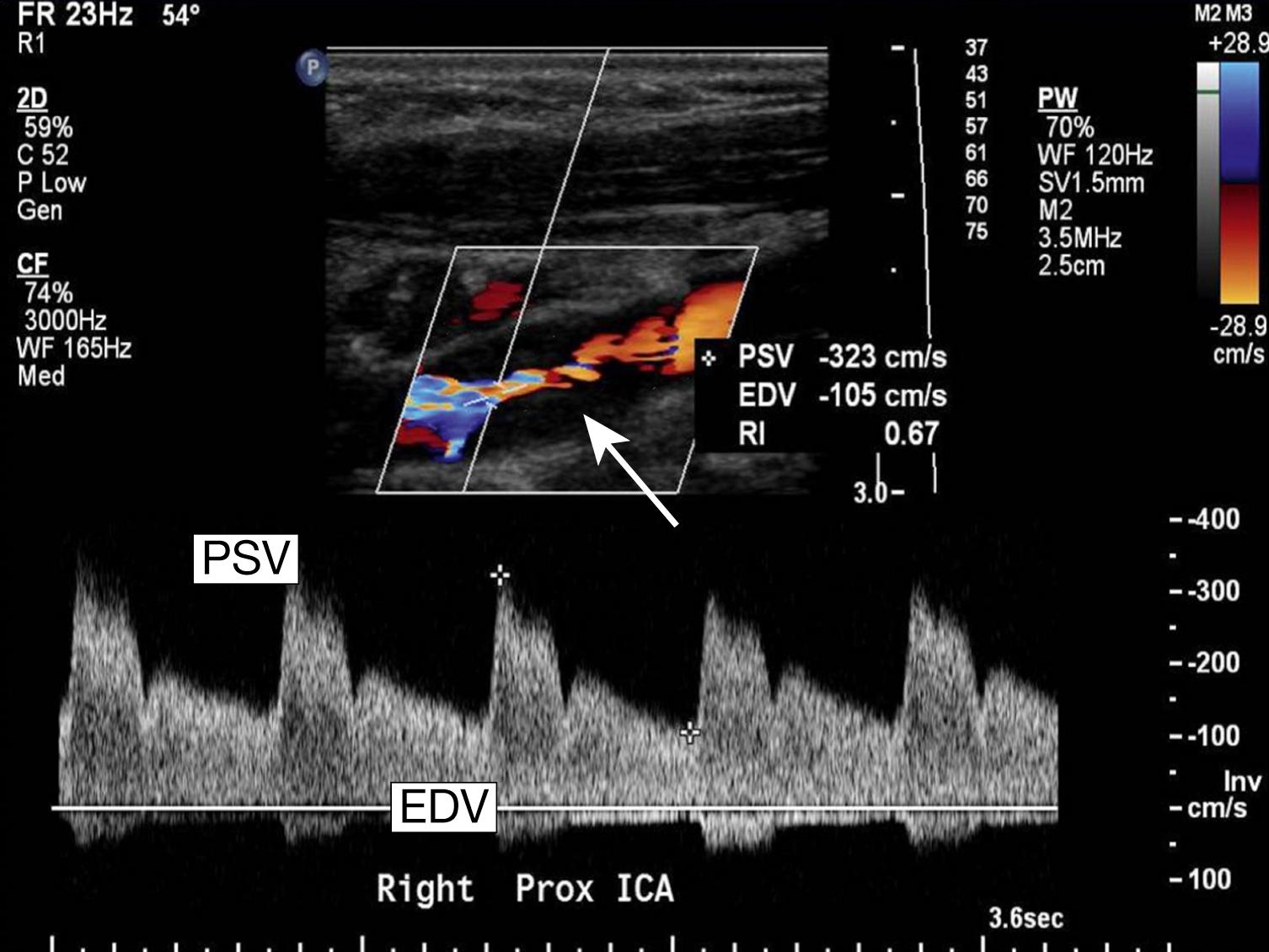
Magnetic resonance angiography (MRA) or computed tomography angiography (CTA) provide excellent images and are increasingly used to plan treatment ( Fig. 22.16 ).
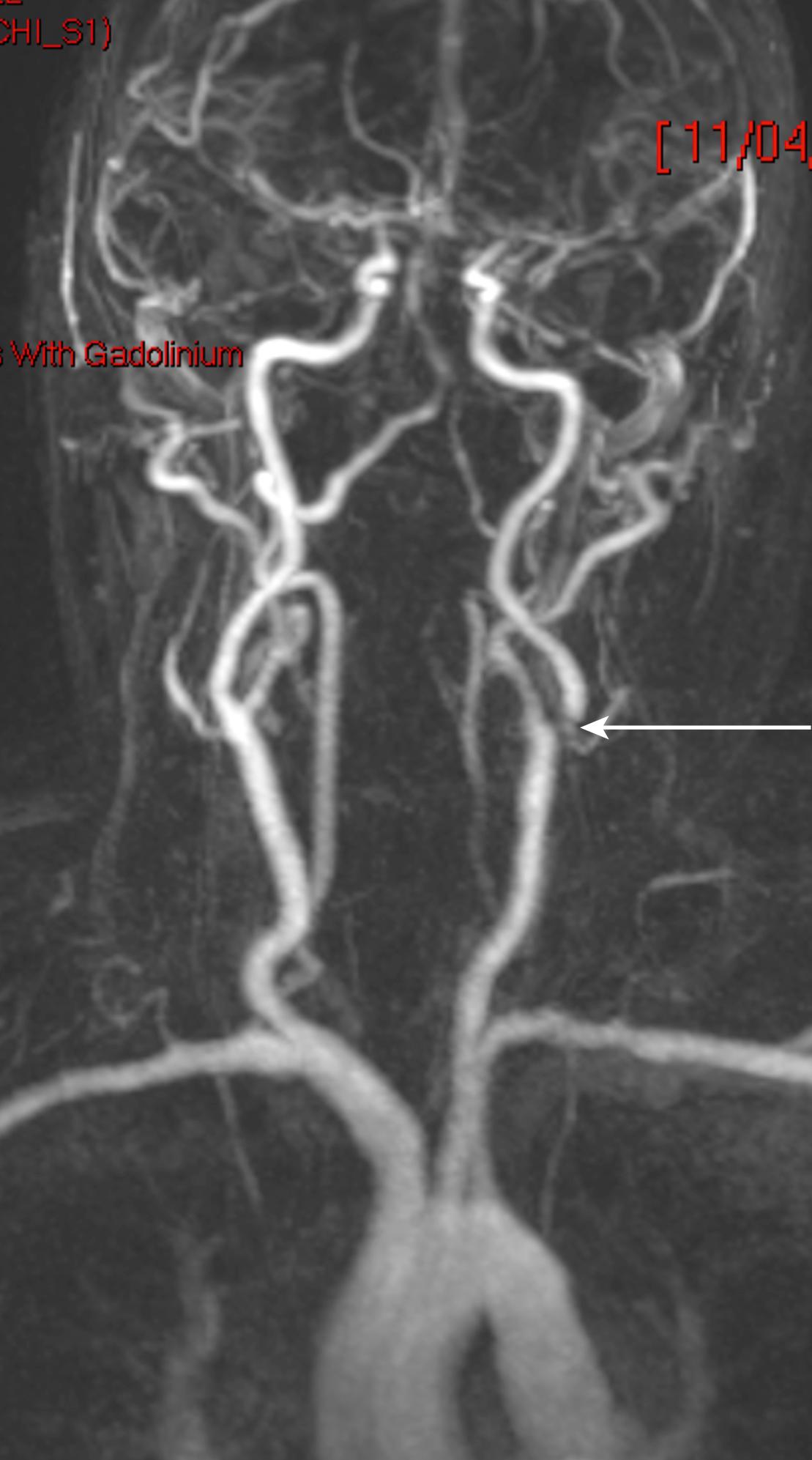
Intraarterial digital subtraction angiography (IA-DSA) is associated with a small risk of TIA/stroke and is now is rarely used for diagnostic purposes.
Become a Clinical Tree membership for Full access and enjoy Unlimited articles
If you are a member. Log in here